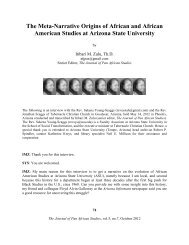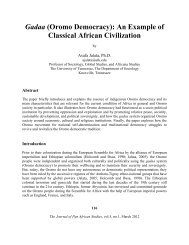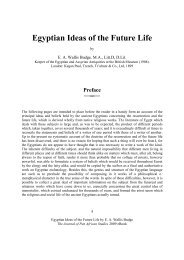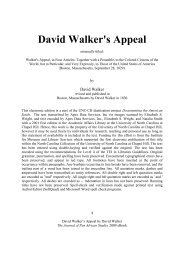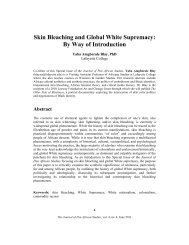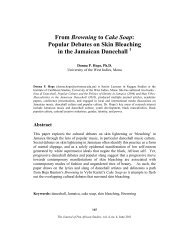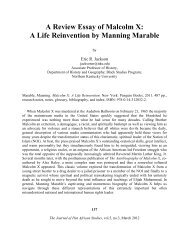The Kilumi Rain Dance in Modern Kenya - Journal of Pan African ...
The Kilumi Rain Dance in Modern Kenya - Journal of Pan African ...
The Kilumi Rain Dance in Modern Kenya - Journal of Pan African ...
Create successful ePaper yourself
Turn your PDF publications into a flip-book with our unique Google optimized e-Paper software.
In December 2008, Ukambani, located <strong>in</strong> South Central <strong>Kenya</strong>, experienced one <strong>of</strong> the<br />
worst droughts recorded. But what is clear, even based on the 2011 drought <strong>in</strong> <strong>Kenya</strong>, is that the<br />
conditions are more frequent and longer with poor ra<strong>in</strong>fall levels severely affect<strong>in</strong>g the<br />
livelihood <strong>of</strong> <strong>Kenya</strong>ns. In an article cover<strong>in</strong>g the 2008 drought <strong>in</strong> <strong>Kenya</strong>, Obadiah Ayoti states,<br />
“…despite the recurrence <strong>of</strong> droughts and their devastat<strong>in</strong>g effects on communities and the<br />
economy, <strong>Kenya</strong> lacks a comprehensive drought management policy.” 5 <strong>The</strong> 2008 drought <strong>in</strong><br />
particular forced community members to pull out drums, rattles, whistles, and special dance<br />
garbs to <strong>in</strong>voke the bless<strong>in</strong>gs <strong>of</strong> water spirits and deities. It is, <strong>in</strong> the essence <strong>of</strong> this particular<br />
moment, that this study is situated. As a result <strong>of</strong> the environmental conditions <strong>in</strong> 2008, research<br />
activities were stalled. Consequently, responses to research questions aimed at another project<br />
turned to rites that addressed the problem <strong>of</strong> ra<strong>in</strong>.<br />
In times <strong>of</strong> distress and hardship, the Wakamba, the ethnic group <strong>of</strong> the region, did not<br />
wait on policy makers and governmental <strong>of</strong>ficials; <strong>in</strong>stead, it was clear that the poor were left on<br />
their own to address issues related to ra<strong>in</strong> unpredictability and <strong>in</strong>stability. <strong>The</strong>refore, they turned<br />
to ritualistic customs to <strong>in</strong>voke power used by their ancestors. As reported <strong>in</strong> a <strong>Kenya</strong>n survey <strong>in</strong><br />
the rural areas <strong>of</strong> Machakos, Kangundo, and Makweni, 95% <strong>of</strong> all participants attested that<br />
rituals were important to Akamba life. 6 This illustrates the importance <strong>of</strong> rituals to <strong>Kenya</strong>ns. 7 It<br />
appears that when societal problems are not expla<strong>in</strong>ed and handled through Western systems,<br />
<strong>African</strong>s turn to traditional customs that <strong>of</strong>fer <strong>in</strong>terpretations, explanations, and, more<br />
importantly, solutions.<br />
This study argues that the study <strong>of</strong> black dance - especially dance rituals - is enhanced<br />
when the form is based on specific people, places, times, and objectives so that the dance is<br />
analyzed aga<strong>in</strong>st all complex structures and processes that make up the dance experience. This<br />
study also shows that <strong>Kenya</strong>ns cont<strong>in</strong>ue to use ra<strong>in</strong> dance traditions as a drought management<br />
strategy <strong>in</strong> the absence <strong>of</strong> modern governmental solutions because the dance <strong>of</strong>fers community<br />
agency, unity, and power dur<strong>in</strong>g precarious periods. This ritual application serves as a cultural<br />
rem<strong>in</strong>der <strong>of</strong> the importance and need <strong>of</strong> traditional knowledge and education. Additionally, the<br />
ra<strong>in</strong> dance ritual satisfies other socio-cultural functions important for the susta<strong>in</strong>ability <strong>of</strong> the<br />
community such as the need to collectively unite dur<strong>in</strong>g a time <strong>of</strong> hardship, to socialize, to<br />
pray/worship, and to heal.<br />
What is a Ritual?<br />
It is difficult to def<strong>in</strong>e rituals. However, most survey participants and scholars appear to<br />
agree that a ritual is someth<strong>in</strong>g enacted for a specific purpose. <strong>The</strong> term can also be expla<strong>in</strong>ed by<br />
nuanc<strong>in</strong>g some <strong>of</strong> its varied <strong>in</strong>terpretations and flush<strong>in</strong>g out the religious aspects <strong>of</strong> the ritual<br />
acts. 8 For example, Emile Durkheim, <strong>in</strong> <strong>The</strong> Elementary Forms <strong>of</strong> Religious Life, attributes ritual<br />
or religious activities as be<strong>in</strong>g “associated with the sacred as dist<strong>in</strong>ct from the pr<strong>of</strong>ane.” 9<br />
173<br />
<strong>The</strong> <strong>Journal</strong> <strong>of</strong> <strong>Pan</strong> <strong>African</strong> Studies, vol.4, no.6, September 2011



